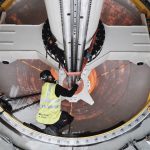EDP – creating sustainable energy solutions to tackle climate change
As CEO of Portugal’s EDP and EDPR, Miguel Stilwell d’Andrade is at the forefront of managing the multinational’s energy transition. A major global energy player, EDP today employs around 13,000 people in 29 markets across Europe, North America, Latin America and the Asia-Pacific. The EDP CEO addressed a select group of British-Portuguese Chamber of Commerce members at a corporate lunch organised in collaboration with the British Embassy Lisbon at the British ambassador’s residence on Thursday, July 11.
Text: Chris Graeme. Photos: Joaquim Morgado
Over the past 24 years EDP CEO Miguel Stilwell d’Andrade has had a pivotal role in making the company a global renewable energy leader through the scale of its renewable energy investments in Portugal and overseas, including notably in the UK where EDPR – its renewables arm – is the largest and most significant Portuguese investor.
EDP’s presence in the UK goes back to 2009 when EDPR entered the UK’s offshore wind sector. Fast-forwarding to the present, EDPR has become one of the most significant players in UK renewable energy.
EDPR is developing offshore wind projects through the company Ocean Winds, a 50/50 joint venture with French multinational Engie with a total of four offshore wind farms, one of which is fully operational, and an increasing number of projects in onshore wind and battery storage sectors.
In 2009 Ocean Winds began the development of Scotland’s biggest wind farm – 950MW Moray East in the Moray Firth which has been in operation since 2022, providing 40% of the electricity demand in Scotland.
Through these investments EDP is playing a critical part in the UK’s clean energy transition with the company’s longstanding commitment to the UK being highly valued, more so since the UK has some of the most ambitious climate targets in the world, with a commitment to net zero carbon emissions by 2050.
An international case study
Miguel Stilwell d’Andrade is proud of the fact that EDP is a world case study on energy transition. Twenty years ago EDP was 80% thermal energy and 20% renewables. In 2024, 97% of the company’s generation is renewable.
“We’ve done this in a very efficient and non-controversial manner by closing down coal-fired power stations over time and investing heavily in renewables. Many people said it was not possible to switch to renewables so quickly, that it would take decades, but it is possible and is not as difficult as some make it out to be,” he said.
“I have no doubts energy transition will happen. It’s debatable how long it will take, and if we can do it by 2050, but it is absolutely urgent” he added, referring to the Paris Agreement in 2015 when 196 countries signed up to keeping global temperatures well below 2ºC (3.6F) above pre-industrial times while pursuing means to limit the increase to 1.5C, as well as reviewing countries’ contribution to cutting emissions every five years.
“This is something I believe in, and governments, companies, people and society collectively has a duty to do it, and it’s one of the key premises we use as a company when thinking about the future”, said Miguel Stilwell d’Andrade.
A €25 million investment plan
Today, EDP’s total emissions are 48% less than they were in 2015 and the company intends to reduce 90% of its absolute emissions by 2040.
To effect the energy transition, EDP has a €25 million investment plan to 2026, of which around €21 million (85%) will be in renewables, including wind, solar, green hydrogen, and battery energy storage technology.
Miguel Stilwell d’Andrade says that as an engineer he believes strongly in technological progress and progress towards efficiency has already occurred in more efficient solar panels and batteries.
The former investment banker points out that not so long ago solar panels cost €400 per MW/h; today that figure has come down to €20 MW/h. Similar cost reductions have occurred with wind turbines and batteries.
However, the EDP CEO admits that it has been “very tough” as it has huge geopolitical impacts on the many economies that are still dependent on fossil fuels.
“This is not just energy transition, it is a revolution, and the impact is absolutely mind-blowing. There will be winners and losers, and we need to think very carefully about how we manage this, not just in the developed world, but in those economies that are going to be heavily hit, but this is about the sustainability of the planet,” he stressed.
Independence and affordability
Miguel Stilwell d’Andrade says that the UK and Europe have taken the lead in pushing for climate change and that urgency is being reinforced by the fact that energy transition will offer greater energy independence and make it more affordable.
The Ukraine War and the weaponisation of energy had made Europe more dependent on imports from the US, which today is probably the most energy independent nation. Not only that, fossil fuels were price volatile with prices being driven up by these geopolitical conflicts.
“Europe is not energy independent, so the more energy independent we can become, the better, and clearly we have a lot of wind and solar”, he said.
Another reason that energy independence is important is affordability. Renewables are more competitive than fossil fuels and prices are not volatile. Stilwell d’Andrade pointed out that once a wind farm or solar park has been set up it is cost effective and the energy will not cost any more in 20 or 30 years time than it does today. “The good thing is once it is installed it’s free and you’re not dependent on imports”, he said.
Phasing out coal
Miguel Stilwell d’Andrade says that he has no doubt that coal will be phased out in Europe, although there would still be coal-fired power stations in China and India, but China was investing more money in renewables.
Nuclear energy may be an option for some countries in certain situations, he said, but certainly not in Portugal, while it is being phased out in Spain and Germany.
“When you invest in nuclear you have to have State backing since no private company will invest in nuclear.”
“It’s not the magical solution, and even if you were to build a nuclear power station, it would not be ready until 2040” he said, giving the example of the UK’s Hinkley Point C nuclear power plant which was expected to be completed by 2027 at a cost of £26Bn, but is now unlikely to be operational before 2030, with the overall cost revised to £31Bn according to EDF.
Instead, Miguel Stilwell d’Andrade says that the future lies with either gas or renewables, or a combination of both.
Capital intensive
One thing that has changed over the past couple of years is the economic and financial macro-environment. Energy transition projects require a lot of capital, numbering trillions of dollars, and the cost of capital has gone up.
According to the Harvard Business Review, for most of the last 15 years, capital had been cheap. Since 2009, the after-tax cost of borrowing for some large companies had been below the rate of inflation, making their debt in real terms cost-free. And for much of this time, the stock market moved steadily upward, consistent with historically low costs of equity. It was estimated that in early 2022, the weighted-average cost of capital (WACC) for the average company in the S&P 500 hovered below 6%.
All that changed in March 2022, when the world’s central banks began raising rates to curb rising inflation. Over the next 12 months, the US Federal Reserve increased its benchmark Fed Funds rate from 0.25% to 4.75% and the yield on 10-year treasury notes climbed from 1.75% to almost 4%. Europe followed that lead.
“That was a problem for companies investing in deploying capital since we basically had free money for many years, and now it has gone up to what it was 20 or 30 years ago,” said Stilwell de Andrade.
And added: “This has certainly changed the capacity for companies to invest at precisely the time when we should be investing, but now it costs two three times more”.
Protectionism is back
Another issue linked to geopolitics is that protectionism is back, and anything to do with energy has become a national security issue, whether it involves China, the US or Europe.
China has developed its own value chain with investments in renewables, while the US introduced the Inflation Reduction Act 2022 which aims to curb inflation by printing and spending more money and investing in domestic energy production while promoting clean energy.
“Europe complained for years that the US wasn’t doing enough to invest in climate change measures, and when they did the Europeans said it had gone too far and needed to scale down as it was making things hard for Europe,” he noted.
“Not only has the US invested a lot in renewables, but it has also become more protectionist. This has brought a lot of investment into the US to build up the supply chain, with a lot of solar and turbine projects there”.
The US is finally, after many years, and after everyone said it was dependant on the Middle East for oil (resulting in conflicts), independent.
The US equally doesn’t want to become dependent on China for resources needed for energy transition.
“The US decided that it needed to be pragmatic and ensure that it was controlling the value chain to do that”, said Miguel Stilwell d’Andrade who is on record for saying that the prospects for growth in the US renewables market are “very strong” for EDPR, a market to which it has dedicated around 40% of its total investment.
Europe, however, has taken a middle road. It wants energy transition but its dependency on and relationship with China is more ambiguous. Europe has not placed tariffs on Chinese imports of solar cells like the US (50% in 2024) or blocked Chinese imports from Chinese companies where, according to Human Rights Watch, there are forced labour concerns.
Own project focused
In an interview with Bloomberg this year, the EDPR CEO said that the company was more focused on investing in its own projects rather than buying renewable energy assets.
EDP has been in the US since 2007, and is now one of the main five operators in the sector there in wind farms, solar parks and battery energy storage.
The US is EDPR’s biggest market in terms of installed capacity and production. EDPR North America is based in Houston, Texas, and maintains offices and wind farms across the United States. The company currently operates 61 wind farms and 15 utility-scale solar parks across the country.
Increased electricity demand
Miguel Stilwell d’Andrade says the world is witnessing an increased demand for electricity driven by artificial intelligence, in part because of the amount of chips being produced and sold by companies like Nvidia – one of the world’s leading producers in AI computing – and the amount of energy needed to supply data centres.
According to White & Case, data centres consume around 3% of the world’s electricity, and this is set to increase in the future as more data is stored and processed in data centers. In the drive towards greener data centres the use of greener power has become one key strategy with a notable rise of co-location of data centres constructed with renewable energy-generating assets.
Currently, when they build a data centre they need to buy green energy to offset emissions. The energy consumed has to be additional, it can’t be purchased from the existing system which would result in price inflation.
In other words companies like Nvidia have to match their 100MW data centres with 100MW of additional renewable power.
“These data centres are exploding in numbers and what we’re seeing is not like anything in the past where companies like EDP get enquires asking if they have enough capacity and connection in the network for a new data centre. Now it’s do you have projects that you can build to provide us with energy”.
Summing-up, Miguel Stilwell d’Andrade said it was exciting times to be in energy, despite the challenges of licensing and permitting, but stressed that the sector did not need more legislation, and pointed to the challenge of the sheer time it has been taking to get EU legislation transposed at a member-state level. “We don’t need a lot of rhetoric, we need execution.”










